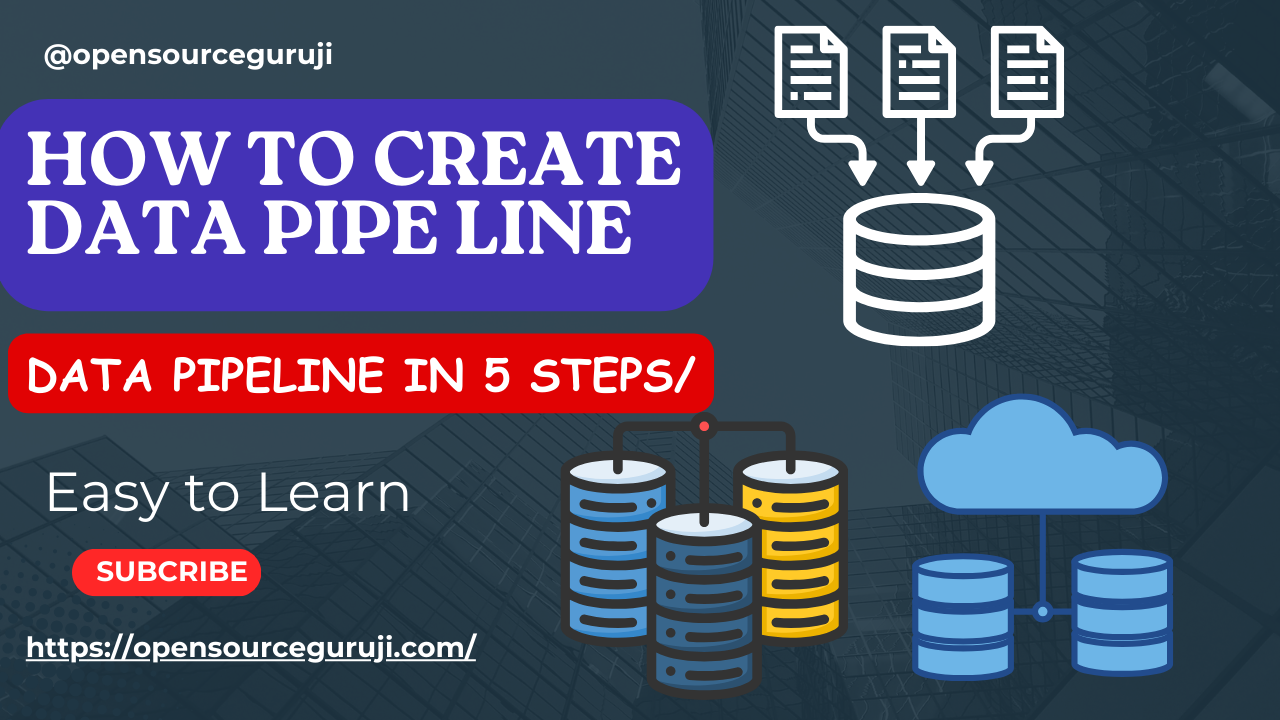Data Pipeline in 5 Steps/How to Create Data Pipe line
What is a Data Pipeline?
Consider a pipeline that transports water from a source, such as a river, to a destination, such as your home. Similar principles apply to a data pipeline, which transports data rather than water. It is a collection of automated procedures that transfer data between several sources, alter it as necessary, and deliver it to a destination for storage or analysis.
Creating a data pipeline entails numerous processes, including data ingestion, processing, storage, and analytics. The following are the general steps for creating a data pipeline:
Define your objectives.
Identify data sources. Determine where your data will originate (e.g., databases, APIs, files, streams).
Determine the data destination: Determine where the processed data will be stored (data warehouse, data lake, databases).
Define Data Transformation. Outline the necessary modifications to clean and prepare the data for analysis.
Key Components of a Data Pipeline:
Source:
This is where the data originates. Databases, programs, log files, sensors, social media feeds, and other types of data may be included.
Ingestion:
Data extraction from the source system is the focus of this step.
Batch Ingestion: Load data at predetermined intervals.
Stream Ingestion: Continuously ingest data in real time.Transformation/Data Processing:
It’s possible that the data in its raw form is unusable. In this case, the pipeline prepares the data for the destination by cleaning, filtering, formatting, and transforming it. This could entail addressing missing values, fixing errors, and creating new functionality.
ETL (Extract, Transform, Load): Data is extracted from sources, transformed to fulfill analysis needs, and then loaded into the destination. ELT (Extract, Load, Transform) is the process of extracting data, loading it into a destination, and transforming it.
- Data Storage
Data warehouses are used to store structured data and execute complicated searches.
Data lakes are used to store massive amounts of structured and unstructured data (for example, AWS S3 and Azure Data Lake).
Databases store transactional data (e.g., MySQL, PostgreSQL). - Data orchestration : Data orchestration involves using tools like Apache Airflow, Luigi, or Prefect to schedule and manage workflows.
Monitoring and logging: Use monitoring to track pipeline performance and identify faults. - Data Quality and Validation. Validation checks ensure data integrity and accuracy.
Error Handling: Create systems for handling and reporting errors. - Data Analysis and Visualization Tools: Use Jupyter Notebooks, R, or Python for analysis.
- Visualization Tools: Use Tableau, Power BI, or Looker for visualization.
- Automation and Optimization.
Automate: Set the pipeline to run at predetermined intervals or in response to certain triggers.
Optimize: Continuously monitor and optimize the pipeline to increase performance. Validation:
Data quality is essential. At this point, the accuracy and completeness of the data are verified to fulfill certain requirements.
Destination:
The final resting location of the processed data. This could refer to a data warehouse, data lake, data mart, or similar analytics platform.
Types of Data Pipelines:
- Batch Processing: Regularly processes huge amounts of data, such as daily or weekly updates. Frequently used for historical data analysis.
- Real-time Processing: Handles data continually as it is generated, making it perfect for applications that require instant insights, such as stock price tracking.
- Micro-batch Processing: Processes data in smaller bits than batch processing but at a higher frequency. Provides a blend of speed and efficiency.
Benefits of Data Pipelines:
- Improved Data Quality: Ensures that the data is clean, consistent, and ready for analysis.
- Automation: Automation eliminates manual data movement, eliminating errors and saving time.
- Scalability: Ability to handle increasing data volumes efficiently.
- Faster Analytics: Provides data for analysis in a timely manner.
- Better decision-making: Provides access to credible data, allowing for educated decisions.
Data Pipeline Tools:
There are several tools available for creating and managing data pipelines. Some prominent alternatives are:
Apache Airflow
Apache Beam
Prefect
Luigi
AWS Glue (cloud-based)
Google Cloud Dataflow (cloud-based)
Microsoft Azure Data Factory (cloud-based)
- Data Ingestion: We collect data from many sources, such as databases, apps, and social media.
- Data Processing: We clean and transform the data to be meaningful. Consider it a pre-work cleaning and organizing session.
- Data Storage: After processing, the data is stored in a data lake or warehouse.
- Data Analysis: Time to Dig Deep! Analysts use structured data to discover insights and patterns that inform decision-making.
Example Implementation
Here’s a simple example using Python and some common tools:
Tools
- Apache Kafka for data streaming.
- Apache Spark for data processing.
- Amazon S3 for data storage.
- Apache Airflow for orchestration.
Data Orchestration with Airflow
from airflow import DAG
from airflow.operators.dummy_operator import DummyOperator
from airflow.operators.python_operator import PythonOperator
from datetime import datetime
def process_data():
# Spark processing code
default_args = {
'owner': 'airflow',
'start_date': datetime(2023, 1, 1),
'retries': 1,
}
dag = DAG('my_dag', default_args=default_args, schedule_interval='@daily')
start = DummyOperator(task_id='start', dag=dag)
process = PythonOperator(task_id='process_data', python_callable=process_data, dag=dag)
end = DummyOperator(task_id='end', dag=dag)
start >> process >> endHow to Create Data pipe line

Original Post and Picture references: https://www.linkedin.com/feed/update/urn:li:activity:7199803501705641984?utm_source=share&utm_medium=member_desktop
In conclusion, data pipelines are the backbone of data-driven organizations. They automate the flow of data, ensuring its quality and facilitating valuable insights. By understanding their components, benefits, and types, you can leverage data pipelines to make the most of your data.
You may like this articles as well. : top 10 AI-powered presentation tools for 2024
